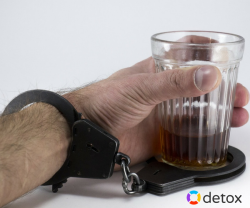Addicted & Incarcerated: Does Jail Help Inmates Recover?
Roughly 65% of the United States prison population has a substance use disorder. However, drug and alcohol treatment programs in prisons are few and far between — meaning inmates who don’t receive treatment often face a higher risk for repeat offenses and death following their release.
Evidence suggests that expanding access to drug addiction treatment in prison can actually reduce drug-related incarceration rates in the U.S. and help addicted inmates become healthier, well-adjusted individuals.
How does jail help individuals recover from addiction? What can be done to improve recovery outcomes among U.S. inmates?
Here’s a closer look at drug and alcohol treatment programs in prisons, and what you can do to help a former inmate recover from addiction.
Addiction in American Jails

One in six male inmates have an alcohol use disorder.
The Federal Bureau of Prisons reports that 43% of inmates have committed a drug-related crime. According to the Bureau of Justice, 31% of state prisoners and 25% of federal prisoners reported drinking alcohol at the time of the offense, and 39% of state prisoners and 31% of federal prisoners reported using drugs at the time of offense.
Many of these inmates are also experiencing a mental health disorder alongside substance abuse issues.
In the U.S., roughly 18% of the general population has a mental health disorder. However, 44% of individuals in jail have a mental health disorder. Prison inmates with mental health disorders are also more likely to suffer substance use disorders than their counterparts without mental health disorders.
What conditions are these inmates experiencing?
- 11.4% of inmates have depression. (The rate among the general population is 6-8%.)
- 9.8% have PTSD.
- 3.7% have a psychotic disorder (twice the rate of the general population).
- 23.8% had an alcohol use disorder when they entered prison.
- 38.9% had a drug use disorder when they entered prison.
It’s clear many inmates are arriving at prison with substance use disorders. But once they get there, is help available to recover?
The Lack of Drug Addiction Treatment in Prison
Less than 20% of U.S. inmates diagnosed with substance use disorders receive drug addiction treatment as needed. But evidence suggests addiction treatment can help reduce drug abuse rates by 50-70% compared to those who don’t receive treatment. This can also reduce criminal activity, arrests, and the demand for drugs across U.S. communities.
In fact, for every one dollar spent on drug addiction treatment, the costs associated with drug-related crimes decreases by between $4 and $7. If healthcare-related costs are included, that savings goes up to $12.
Inmates who do receive treatment for their substance use disorders may only receive drug education or behavioral treatment, which are the most commonly used methods for treating drug and alcohol addiction in the U.S. criminal justice system. While roughly 44,000 inmates are members of AA, this type of 12 Step program alone isn’t always enough to help inmates overcome their substance use disorders in full.
Only 43.8% of jails in the U.S. reported offering any form of medication assisted treatment (MAT) for opioid use disorder. Among those jails, less than 13% made this treatment available to anyone with the disorder.
This lack of treatment can contribute to overdose deaths among the previously incarcerated. In fact, overdose is the leading cause of death among those returning home after incarceration. One study discovered that 21% of overdose deaths were individuals who had been in jail.
These deaths are typically the result of relapse.
Relapse Risk Among Former Inmates
Inmates who suffer from substance use disorders and who fail to receive drug addiction treatment in prison face a high risk for relapse and death within two weeks following their release. A study examining overdose death rates among former prisoners found that mortality rates were 10 times higher among this population for the first two weeks after release compared to that of the general population.
During incarceration, addicted inmates lose tolerance for alcohol and any drugs they were using, which means their bodies may only need small doses of these substances to experience the effects. After being released from prison, those still struggling with drug dependence and addiction may suffer an unintentional overdose after returning to using the same doses they were using prior to being incarcerated.
Evidence also suggests that some former inmates may overdose on drugs intentionally to escape certain situational and environmental stressors, such as those related to transitioning back to life within the community. One study found that the highest mortality rates during the first week after release are related to alcohol and drug poisonings, which can include accidental or intentional overdose.
Which Treatments do Addicted Inmates Need?
Addicted inmates need the same treatments as everyone else in order to fully conquer and overcome addiction. Detoxification, therapy, and aftercare are vital components of any successful addiction treatment program.
Even when jails and prisons do provide drug addiction treatment, the continuation of treatment in the form of aftercare and extended care programs following incarceration can help former inmates stay sober and healthy. Untreated drug use disorders among inmates can lead to a return in criminal activity, reincarceration, and risky, impulsive behavior that can lead to the spreading of serious diseases like hepatitis and HIV.
Call now to find addiction recovery programs for yourself or a loved one.
How Many Addicted Inmates Return to Jail?
Many inmates who struggle with addiction start using drugs again shortly after their release. Former inmates who don’t suffer fatal drug overdoses often end up being arrested once again for drug-related crimes. Researchers have found that those with substance use disorder are at higher risk of recidivism than those who don’t have an SUD. In fact, an estimated 25% of inmates released from prison become reincarcerated within three years for various technical violations that include testing positive for drug use.
Former inmates with substance use disorders have reported that many halfway houses, homeless shelters, and similar types of environments offer high levels of exposure to drugs, alcohol, and drug trafficking. Environmental exposure to these factors make it difficult for former inmates to stay sober, overcome addiction, and avoid committing new drug-related crimes to fuel their addiction.
A group of former inmates with substance use disorders who were interviewed following their release from prison cited exposure to drugs as the top challenge they faced in regards to staying sober. Many of these former inmates reported they lacked skills that would otherwise help them overcome relapse triggers and avoid situations involving drugs and alcohol.
Some former inmates who suffer from addiction decide to abscond on purpose shortly after release just so they can go back into prison. Former inmates with drug use disorders have reported they often lack housing, financial security, and social support after release from prison — all of which are environmental factors that can drive the risk for drug abuse, crime, relapse, and death.
Many former inmates who struggled with addiction prior to incarceration and who purposely abscond may do so to avoid exposure to environments where they might relapse. For instance, former inmates who were once dependent on heroin and who are released to halfway houses in communities where heroin is readily available may abscond to avoid relapse and to prevent themselves from having to experience heroin withdrawal.
How the Issue is Being Addressed
The U.S. Sentencing Commission reports that offenders who completed a Residential Drug Abuse Treatment Program were 27% less likely to recidivate than those who didn’t participate in one of these programs. But does jail help individuals truly overcome addiction in full?
It is estimated that more than 80% of state and federal prisons offer some type of counseling, education, or awareness program concerning drugs and alcohol. However, with less than half of jails offering MAT for opioid use disorder, and among those, many not making it highly accessible, it’s likely many inmates aren’t getting the type of treatment they need.
In 2016, Rhode Island started offering medication-assisted treatment to prison inmates suffering from opioid use disorder. The majority of inmates chose either buprenorphine or methadone to treat opioid dependence, though naltrexone was also available. After six months, the treatment program produced a 61% decrease in drug overdose deaths following incarceration.
NIDA Recommendations
Treatment providers that work with U.S. criminal justice systems are urged to adhere to the Principles of Drug Abuse Treatment for Criminal Justice Populations, published by the the National Institute on Drug Abuse (NIDA).
Summarized, these principles are:
- Recognize and acknowledge that drug addiction is a chronic brain disease that affects behavior.
- Understand that recovery from addiction requires effective treatment followed by aftercare.
- Provide a duration of treatment long enough to produce stable changes in behavior.
- Perform an assessment as the first step of treatment.
- Personalize drug addiction treatment to meet the needs of the individual.
- Carefully monitor drug use during treatment, such as methadone use.
- Use treatments that target factors linked to criminal behavior, such as CBT, which helps identify and improve negative thoughts and behaviors surrounding drug use and crime.
- Plan and facilitate treatments for inmates who abuse drugs, while staying aware of correctional supervision requirements.
- Arrange for addicted inmates to join continuing care and aftercare programs upon re-entering the community.
- Offer rewards and sanctions to encourage participation in drug addiction treatment.
- Understand that dual diagnosis treatment will be needed for inmates who suffer co-occurring drug addiction and mental health disorders.
- Understand that medications are proven effective at helping inmates recover from substance use disorders.
- Develop treatment plans for inmates about to be released that consist of strategies that prevent and treat drug-related medical conditions, such as HIV, AIDS, hepatitis, and tuberculosis.
What Else Can We Do?
There are many barriers that stand in the way of drug addiction treatment for U.S. inmates, such as lack of financial resources, lack of organization surrounding treatment programs, and lack of trained medical staff. Though drug use disorders and addiction are medical conditions, these disorders tend to remain stigmatized in the criminal justice system. As a result, addiction treatment isn’t always guaranteed or available for inmates who need help recovering from drug use disorders.
What else can be done to improve recovery outcomes and reduce drug-related incarceration rates in the U.S.?
- Those in police custody should be screened for drug use disorders and treated for withdrawal.
- The criminal justice system must facilitate MAT and other treatments for inmates upon arrival to prison.
- Inmates who suffer from addiction must be connected with community-based treatment programs and continuing care following release.
- Court-ordered rehab may also be an option for offenders who have committed nonviolent drug-related crimes.
These strategies may help prevent relapse, reduce the risk for overdose death, and reduce recidivism rates.
If you or a loved one has recently been released from prison, understand that drug addiction treatment can help you or your loved one lower the risk for relapse and reincarceration. Use our drug detox center directory to find an addiction treatment center near you, or call 800-996-6135 24/7 to discuss your many treatment options.


